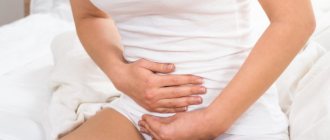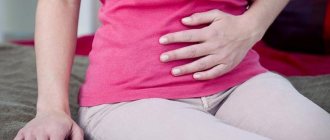Diarrhea and bloating in a child
All pathological processes that cause diarrhea and gas in an adult are associated with irritation of the intestinal mucosa.
This is not always the penetration of infection. Similar symptoms can develop due to nervous tension or changes in hormonal levels. Causes of flatulence and loose stools:
- Irritable bowel – dysfunction of the organ for 3 or more months. The pathogen has not been identified, the balance of beneficial and opportunistic flora is not disturbed.
- Dysbacteriosis is a violation of the ratio of various bacteria inhabiting the intestinal tract. Accompanied by nausea, loose stools, and gases. In difficult cases, green stool, inclusions of blood, and pieces of food are present.
- Lactic sugar intolerance – diarrhea develops after drinking milk and goes away on its own after bowel movement.
- Celiac disease is intolerance to proteins from cereal plants. Accompanied by the death of the villi lining the stomach. Typical symptoms are severe abdominal pain and prolonged increased gas production.
- Intestinal obstruction – in the presence of tumors, purulent processes. Excess gases are accompanied by constipative diarrhea, in which feces are released frequently and in small portions. There is some blood present.
- Intoxication of various etiologies, infection with a fungus of the genus Candida. A typical symptom is gurgling in the gastrointestinal tract.
- Pancreatitis is an inflammatory process in the pancreas. In the chronic form, the pain syndrome is not pronounced, but flatulence is observed.
- Pregnancy in women - when the fertilized egg is implanted, a change in hormonal levels occurs. This may be accompanied by bloating and diarrhea in adults.
- The phase of the menstrual cycle in women of the reproductive period - the gastrointestinal tract system responds to changes in hormonal levels. Sometimes the condition occurs before menstrual bleeding.
Bloating and diarrhea often bother children, especially in summer. Most often, pathological symptoms appear due to an intestinal infection. If there is no increase in body temperature and vomiting, it will not be difficult to overcome the pathology. To normalize the condition, a diet and increased drinking regimen are necessary.
If you experience an increase in body temperature, this may indicate a serious illness. In such a situation, it is better to consult a doctor as soon as possible. Other most common causes of diarrhea and bloating in a child:
- enzyme deficiency;
- taking medications;
- dyskinesia of the gastrointestinal tract;
- diseases of the digestive tract;
- viral infections.
Symptoms such as diarrhea and bloating, although seemingly harmless, may indicate serious illness. That is why their appearance should force you to consult a doctor. This will help relieve the condition faster and reduce the risk of developing severe complications.
The main causes of diarrhea and bloating include irritable bowel syndrome. It appears when the functions of the gastrointestinal tract are disrupted and is accompanied by additional symptoms in the form of rumbling and pain. Other main reasons include:
- Lactose intolerance. The pathology is congenital and manifests itself in the form of bloating and diarrhea due to the consumption of milk and products based on it. Symptoms disappear after emptying the intestines.
- Dysbacteriosis occurs due to an imbalance of the microflora of the gastrointestinal tract. The main cause is Helicobacter pylori. Microorganisms release toxins. When bacteria begin to actively multiply, the level of harmful substances increases greatly and begins to predominate. As a result, food is poorly digested and begins to rot. Fermentation of its residues and increased gas formation appear.
- Intestinal obstruction occurs due to mechanical obstructions. As a result, constipation appears. Feces are not completely excreted; the remains are mixed with mucus and pus.
- Infectious pathologies and poisoning are often caused by Escherichia coli. When pathological microorganisms begin to actively multiply, this provokes excessive gas formation and diarrhea. It happens that a person has a fever, nausea with vomiting, and abdominal pain.
- Celiac disease is a genetic pathology. The disease affects the intestinal mucosa. In this case, there is an intolerance to gluten and similar proteins. The result is belching, heartburn, bloating and diarrhea.
We recommend watching the video
They can be caused by menstruation. Abdominal enlargement and diarrhea occur before or at the beginning of a cycle. The cause is the hormone progesterone, spasms in the uterus and an increase in the concentration of substances that enhance gastric motility. Other factors for bloating and diarrhea include frequent stress, intestinal inflammation, snacking while walking, and rapid “swallowing” of food. Sometimes the cause is surgery.
You may also be interested in: How to treat bloated intestines
There are a number of diseases that can cause diarrhea and gas in an adult:
- Chronic gastroduodenitis. They arise due to inflammation of the gastrointestinal mucosa and subsequent disruption of the digestion process.
- Diarrhea and abdominal enlargement often appear against the background of oncology and pancreatitis. The cause is a deficiency of enzymes needed by the gastrointestinal tract to break down food. Also the cause is a tumor that interferes with the normal movement of feces and compresses the intestines. As a result, organ obstruction occurs.
- Ulcerative colitis. This is inflammation of the intestines. It can cause cancer or internal bleeding.
- Crohn's disease, unlike ulcerative colitis, does not affect only the intestines, but spreads throughout the body. Symptoms include diarrhea and flatulence.
Main causes and symptoms
The formation of gases in the intestines is a natural process. Any healthy person’s digestive organs contain from 200 to 500 ml of the gas mixture (this volume is completely imperceptible and does not cause any inconvenience). Its amount is influenced by the food consumed, lifestyle and age of people. But sometimes it happens that the amount of gaseous products in the stomach increases significantly and they begin to cause discomfort. A person affected by this phenomenon develops colic and increased flatulence. Diarrhea may also occur. The main reasons that directly cause bloating may be the following:
- Aerophagia (swallowing excessive amounts of air while eating). It can appear in cases where a person eats food very quickly or talks while eating, and, accordingly, causes rumbling in the stomach.
- Gases also appear in large quantities when fermentation or putrefactive processes are started in the digestive organs, provoking increased gas formation.
- Microorganisms living in the intestines and helping to digest food also emit a gaseous mixture during their vital activity. A pathological increase in their number causes bloating and flatulence.
- Climbers may also experience stomach rumbling. In this case, it is triggered by a sharp rise to a high altitude.
These mechanisms of increased gas production influence the fact that a person’s stomach begins to swell and rumbling sounds appear in it. Increased flatulence also depends on them.
Gases accumulated in large quantities in the digestive organs disrupt the production of digestive enzymes. This negative process leads to the fact that the food bolus cannot be completely digested and enters the intestine unprepared for further breakdown. As a result, the formation of toxins occurs in the gastrointestinal tract, and fermentation and rotting begin, provoking increased gas formation, rumbling and flatulence.
Certain foods – cabbage, apples, legumes – can also stimulate the negative process. In people with lactose intolerance, such unpleasant symptoms, which may be accompanied by diarrhea, occur after drinking milk. Discomfort also occurs when a person eats yeast products in large quantities or drinks beer and kvass. It provokes increased flatulence, as well as bloating and pregnancy. The cause in this case is compression of the intestines by the uterus.
Causes of disorders
There are many causes of bloating and diarrhea. Usually this is a digestive disorder, which is easy to deal with. But if pathological symptoms persist for a long time, this may indicate more serious health problems. They require proper treatment, but first you need to establish the causes of bloating and diarrhea.
The cause of the development of the pathological condition is a dysfunction of the nervous system and digestive tract organs. Provoking factors are:
- non-compliance with the rules of rational nutrition;
- pregnancy;
- childbirth;
- hereditary predisposition;
- long-term influence of stressful situations;
- chronic fatigue.
In medical practice, it is customary to distinguish 3 types of disease. The first is characterized by prolonged constipation. It provokes them to eat solid food. The process of defecation occurs no more than 3 times every 7 days.
The second type is accompanied by frequent diarrhea. It appears as a result of the accumulation of a large amount of feces, which pulls on the intestinal walls. As a result, increased peristalsis is observed and diarrhea appears. The patient can visit the toilet up to 5 times a day.
The third type is characterized by an increased level of gas formation. Abdominal pain appears, which has no clear localization. And also a feeling of nausea, vomiting, bloating and gas formation.
The intensity of pathological symptoms can vary, much depends on the individual characteristics of the body. Some patients even complain of sleep disturbances and the appearance of an unmotivated feeling of anxiety.
Dysbacteriosis
The development of intestinal dysbiosis is provoked by an imbalance of microflora. Most often this happens due to long or frequent courses of antibiotic therapy and non-compliance with the rules of a balanced diet. Gases accumulate in the intestines, combining with leftover food, causing bloating. In parallel with this, increased peristalsis is observed and diarrhea appears.
The main symptoms of dysbiosis are:
- bloating;
- increased level of gas formation;
- diarrhea;
- pain in the head;
- general weakness;
- seizures in the corners of the mouth;
- the appearance of rash elements on the skin.
Pathology can be congenital or acquired. Congenital lactose intolerance is characterized by diarrhea and flatulence that are present from birth.
The main clinical manifestation of the pathological condition is nausea. It appears some time after consuming dairy products. In parallel with this, the person is worried about vomiting, abdominal pain and even seizures. Young children lose their appetite, become irritable and capricious.
Celiac disease
The disease is inherited at the genetic level. Celiac disease refers to the destruction of intestinal villi under the influence of the negative influence of proteins (gluten, avenin, hordein, etc.). As a result, the process of absorption of nutrients stops.
The disease manifests itself with the following symptoms:
- pain in the abdomen (after eating);
- diarrhea that alternates with constipation;
- the appearance of undigested pieces of food in the stool;
- blood in the stool (may indicate internal bleeding);
- increased level of gas formation;
- decrease in the number of red blood cells and hemoglobin;
- feeling of nausea;
- brittle nails and hair;
- muscle and bone pain;
- pallor of the skin.
The provoking factor in the development of intestinal obstruction is the formation of polyps in its cavity. New growths prevent the passage of gases.
The main symptoms of the pathology are:
- pain in the navel area;
- vomit;
- constipation;
- bloating;
- change in the shape of the abdomen.
Over time, dehydration develops. It is accompanied by dry mouth, thirst and increased body temperature.
In severe cases, internal bleeding and shock develop, which threaten a person's life. Unbearable abdominal pain and vomiting appear (vomit is dark in color, similar to the color of feces). Blood impurities may also appear in the stool. There is a risk of intestinal perforation, which can be fatal.
Poisoning
Poisoning can be drug or food poisoning. It is necessary for a sick person to provide first aid and call an ambulance. Toxic substances enter the bloodstream and poison the body, the functioning of internal organs is disrupted, and there is a risk of death.
A pathological condition appears:
- the appearance of pain in the head;
- body aches;
- increased body temperature;
- general weakness;
- nausea and vomiting;
- bloating;
- diarrhea;
- flatulence.
Intestinal infection
The provoking factor in the development of pathology is the entry of pathogenic microorganisms into the body. In this case it is observed:
- pain in the abdominal area, which is cutting in nature;
- increased level of gas formation;
- loss of appetite;
- worsening sleep and falling asleep;
- diarrhea;
- nausea;
- vomit;
- weakening of the immune system.
Pancreatitis
Pancreatitis is characterized by the development of an inflammatory process in the pancreas. It is characterized by the following pathological symptoms:
- abdominal pain, localized around the navel;
- increased body temperature;
- change in skin color, it becomes greenish;
- diarrhea that alternates with constipation;
- feeling of nausea;
- vomiting (vomit contains bile);
- increased blood pressure;
- excessive sweat;
- labored breathing;
- bloating;
- the appearance of undigested food residues in the stool.
Gastric candidiasis
Fungi provoke the development of candidiasis of the stomach. The onset of the disease is difficult to notice. A person experiences loss of appetite, difficulty swallowing, and an unpleasant taste in the mouth after eating. In parallel with this, other symptoms of the disease are also disturbing:
- nausea;
- vomiting (vomit is cheesy in nature);
- diarrhea (stool contains mucus and white streaks);
- pain in the upper abdomen;
- increase in temperature indicators;
- white coating on the tongue;
- bloating;
- general weakness.
Gastroduodenitis
Gastroduodenitis should be understood as inflammation of the duodenum. The clinical picture of the pathology is similar to the development of gastritis. The pathological condition manifests itself as follows:
- abdominal pain;
- belching;
- nausea;
- heaviness in the stomach;
- pain in the upper abdomen;
- impaired intestinal function, which manifests itself as constipation and diarrhea;
- loss of appetite;
- sleep disorders;
- lethargy;
- changes in skin color, it becomes pale.
The pathology is characterized by the development of an inflammatory process in the intestinal walls. The main symptom of colitis is the appearance of blood in the stool during diarrhea. A blood test will show a decrease in hemoglobin, a decrease in the number of red blood cells and a high ESR.
In parallel with this, the following symptoms appear:
- pain in the left side of the abdomen of a sharp nature;
- gurgling in the stomach;
- false urge to defecate;
- blood or pus in the stool;
- aches in muscles and bones;
- decreased blood pressure;
- temperature increase;
- loss of appetite;
- weight loss;
- bloating.
The disease requires mandatory treatment. The pathological process can cause the formation of a malignant neoplasm or internal bleeding.
Crohn's disease
Crohn's disease is very similar in clinical manifestations to colitis. The only difference is that it applies to all organs of the digestive tract. The following pathological symptoms are observed:
- weight loss;
- decreased immunity;
- the appearance of fistulas;
- diarrhea;
- ulcers;
- temperature rise to high levels;
- pain in the abdominal area;
- chills;
- restriction of joint movement;
- intestinal obstruction.
Menstruation
The appearance of diarrhea and bloating in women can also be triggered by menstruation. Pathological symptoms usually appear at the beginning of the cycle. This occurs as a result of spasmodic contractions of the uterus and an increase in the amount of substances in the bloodstream that stimulate gastric motility. The disruption of the functioning of the digestive tract is caused by the influence of the hormone progesterone, which is activated on the eve of critical days.
Root causes and signs
Increased gas formation is associated with putrefactive processes in the intestines. Due to a lack of food enzymes in the body, some of the food enters it undigested, which is why it is not completely broken down. Sometimes bloating and nausea are caused by eating certain foods, such as cabbage, beans, beer, apples, milk, and yeast products. The stomach can also swell during pregnancy, when the uterus squeezes the intestines.
Healthy people have up to 500 ml of gases in their bodies, which do not cause any discomfort. And only if they increase significantly, unpleasant sensations may appear in the digestive organs. They contribute to bloating, colic and diarrhea. There are many reasons why they can manifest themselves: from banal dysbiosis or food poisoning to serious pathological disorders. The symptoms of the most common ones are presented in the table.
Some people may experience “senile flatulence” as they age. The reasons may be:
- atrophy of the muscles of the intestinal walls;
- age-related lengthening of the intestine;
- reduction in the number of glands that secrete enzymes.
The signs of a particular disease may be blurred or mixed. Therefore, making a diagnosis without consulting a specialist is impractical, and sometimes even life-threatening.
What to do when the condition is constant
If such symptoms occurred once and went away on their own after a bowel movement, then there is no need to worry.
If the condition occurs regularly and is constantly accompanied by other symptoms, you should analyze what provokes flatulence and stool disorder.
A transition to a gentle diet with the exclusion of foods that promote bloating and have a laxative effect is indicated.
If home measures and diet do not help, you should go to a medical institution and be examined. Without identifying the cause, stool disorder will continue.
Prevention
To reduce the risk of diarrhea and flatulence, it is recommended to adhere to a strict diet that excludes the consumption of foods that contribute to bloating (legumes, cabbage, bananas, radishes, potatoes), as well as carbonated drinks. While eating, you should not be distracted by talking with others, reading newspapers, or watching television channels. It is important to stop smoking (a significant concentration of air enters the body during a puff on a cigarette). Chewing gum also contributes to the accumulation of gases in the digestive organs. It makes sense to lead an active lifestyle, regularly engaging in physical exercise (sports) in order to prevent stagnation in the intestines. The rules of hygiene should not be neglected.
If unpleasant symptoms appear, it is not recommended to self-medicate: only a doctor can determine the cause of the disease and prescribe the optimal treatment.
source
Associated symptoms
You should definitely consult a doctor if the following symptoms appear, accompanied by diarrhea and bloating:
- pain in the abdomen;
- diarrhea;
- burning sensation in the stomach;
- belching;
- rumbling in the stomach;
- increased gas formation, which provokes flatulence;
- feeling of nausea;
- vomit;
- increase in body temperature.
Due to the fact that the listed symptoms are similar to the clinical picture of irritable bowel syndrome, patients try to be treated at home. Such actions bring only temporary relief, but the risk of complications and more severe diseases increases.
Pathological preconditions
Gases produced in the digestive organs can increase in volume several times due to the development of certain diseases in the digestive system. In this case, the appearance of negative signs will be accompanied not only by rumbling in the stomach, but also by nausea, diarrhea or constipation, rotten belching and constant acute pain in the abdominal cavity. Experts note the following pathological conditions:
- Mechanical flatulence. It is caused by the fact that some obstacle appears in the digestive tract, preventing the free passage of the gas mixture (tumors, narrowings or adhesions).
- Enzyme deficiency, that is, a pathological disorder in the formation and release of bile acids and the absorption process. This leads to the fact that the bulk of food enters the intestines unprepared for further breakdown, and fermentation and rotting begin there, increasing the production of gases.
- Inflammatory diseases of the gastrointestinal tract (Crohn's disease, pancreatitis, colitis). With their development, in addition to rumbling and flatulence, a person always develops diarrhea.
- Non-inflammatory pathologies of the gastrointestinal tract also provoke the appearance of rumbling sounds in the abdominal cavity. These diseases include dysbiosis and intolerance to certain nutrients. These ailments, which occur with increased gas formation, are also always accompanied by diarrhea.
- Psychogenic diseases also lead to the appearance of this unpleasant phenomenon. Overexcitation of the nervous system provokes the occurrence of muscle spasms in the intestines, which causes a decrease in peristalsis.
https://youtube.com/watch?v=ZyJpSZ7xUlQ
It often happens that several negative reasons overlap each other. This situation leads to the appearance of belching, acute pain and heartburn along with rumbling and bloating.
Review of medications for flatulence
Among the causes of flatulence are diseases of the gastrointestinal tract, which include:
- pancreatitis;
- chronic gastroduodenitis;
- gastric candidiasis.
These diseases lead to emergency evacuation of feces from the intestinal cavity. Causes increased gas formation. Treatment requires a full examination, on the basis of which the doctor determines the range of medications needed.
If there is a violation of defecation and excessive gas formation, the causes of this condition should be identified. Otherwise, the medications will mask the symptoms, and after finishing the treatment, all the unpleasant sensations will return in full.
Groups of medications indicated for bloating and diarrhea in adults:
- Defoamers - the active substances of these drugs reduce the surface tension in the shell of the bubble with gases, they leave naturally. The main component of these drugs is simethicone. Typical representatives are “Espumizan”, “Colikid”, “Dimethicone”.
- Enterosorbents are drugs with high absorption capacity. These are activated carbon, Enterosgel, Enterol. After administration, gas bubbles are absorbed by the surface of the sorbent. In addition, such drugs have a mild fixing effect. This allows you to stop the diarrheal process.
- Medicines that improve intestinal motility. A typical representative is Motilium. Gases are eliminated naturally, but due to increased motor activity of the intestines, the evacuation of feces also accelerates.
- Herbal preparations – dill water, Plantex. They relieve increased gas formation, relieve intestinal spasms, and are a mild sedative.
- Antispasmodics - Drotaverine, No-shpa - relieve spasms, alleviate diarrhea, pain, bloating.
- Drugs to stop diarrhea - Smecta, Imodium, Loperamide. Their mechanism of action is different. Loperamide preparations, including Imodium, slow down intestinal motility and the speed of passage of feces. Smecta has a sorption, enveloping effect on the intestinal mucosa.
These drugs are symptomatic treatments and do not affect the causes of defecation disorders.
Loading …
Nutrition correction
A diet for this pathology must be followed without fail. It is thanks to it that it is possible to quickly normalize the functioning of the digestive organs and prevent the further appearance of bloating and rumbling. It is necessary to temporarily exclude from the diet those foods that cause the development of putrefactive and fermentation processes in the intestines. Dishes that contain food components that stimulate the secretion of gastric juice are also subject to restrictions. The objectives of such dietary nutrition are:
- ensuring adequate consumption of microelements and vitamins necessary for life;
- normalization of the motor function of the digestive organs;
- reducing the processes of putrefaction, fermentation and inflammation in the colon;
- restoration of normal microflora in the intestine.
General recommendations also include the fact that if a person is prone to rumbling sounds in his stomach, he should not get carried away with dairy products and fresh bread. It is strictly not recommended to eat dry food or on the go. Compliance with drug therapy, along with the rules for correcting nutrition, and a person leading a healthy lifestyle will allow him to forever forget about such a delicate problem as the appearance of rumbling sounds in the stomach.
Bloating and diarrhea are unpleasant symptoms of many gastrointestinal diseases. Very often, stool upset and increased gas formation are accompanied by abdominal pain, heartburn, belching, rumbling, and a high body temperature may rise. In some cases, nausea and vomiting occur.
Diagnostics
When visiting a doctor, a specialist collects anamnesis, examines the patient and palpates the abdomen. With flatulence, it will be enlarged, and a rumbling sound can be heard in it. To make a correct diagnosis, a series of studies may be required:
- general blood analysis;
- biochemical blood test;
- coprogram;
- X-ray;
- Ultrasound OBP.
The listed examinations make it possible to diagnose pathological conditions such as gastritis, colitis, neoplasms, and cholecystitis. To identify peptic ulcers and intestinal obstruction, an endoscopic examination will be required.
When bloating and loose stools appear, stool is analyzed to identify or rule out the presence of parasites or pathogenic bacteria. Blood and urine tests are also performed. During biochemistry, a decrease in red blood cells indicates an inflammatory process. This is how ulcerative colitis is determined. Coprology helps determine the composition of the intestinal microflora. This diagnosis is used for pregnant women and assessing the condition of children.
Basic approaches to treatment
The first thing the doctor will recommend in case of complaints of diarrhea and bloating is optimizing the food menu. With its help, you can stop further progression of the disease and alleviate symptoms. To do this, you need to remove from the menu fried foods seasoned with hot spices, flour, dishes with a lot of fat, smoked foods, pickles, sauces and milk. For certain diseases, certain vegetables and fruits are also prohibited, including fresh cucumbers, tomatoes, cabbage, apples, strawberries, etc.
Conversely, to alleviate the condition, the menu should include products such as:
- Porridges cooked in water;
- Baked apples, zucchini, pumpkin, beets, potatoes;
- Boiled dietary meat: turkey, chicken, rabbit, veal;
- Compotes from dried fruits, as well as jelly from currants, chokeberries, viburnum, cranberries;
- Galette cookies;
- Dried bread.
If spasms or pain occur, it is advisable to take No-shpa. Espumisan will help reduce bloating, and Diosmectite or Simethicone will help reduce gas formation.
To eliminate diarrhea, use Imodium or Loperamide. You need to be careful when taking the latter, since exceeding its dosage can cause constipation after curing diarrhea.
Comprehensive drug treatment prescribed by a gastroenterologist will help completely eliminate the causes of bloating and diarrhea. Recommended ones include:
- Agents that reduce gas formation and improve intestinal motility. The drug that has proven itself best in this case is Simethicone, which should be taken with meals;
- Defoamers – prevent the formation of gas bubbles in the digestive tract and remove excess gas from the body;
- Sorbents - perform an identical function (Enterosgel, Smecta);
- Sedatives to increase stress resistance and prevent the influence of neurotic factors on the development or worsening of gastrointestinal diseases.
Following medical recommendations will significantly speed up the healing process.
Treatment methods
For effective and quick help, it is necessary to find out the cause of the disease. Therapy includes a set of activities. If diarrhea and bloating are a temporary and one-time disorder, then treatment can be done at home. In the case of periodically recurring symptoms and constant discomfort in the abdominal cavity, long-term treatment is required, in some cases even inpatient treatment.
Various medications are prescribed, including activated carbon, Enterosgel, Linex, Stopdiar and others. If the cause is pathogenic microorganisms that increase gas formation, then you must first take a course of antibacterial drugs that sterilize the intestines, and then a course of probiotics that “populate” the cavity with the necessary bacteria and bring the patient’s condition back to normal.
It should be remembered that improper treatment can lead to chronic diarrhea, which will last for years. It is recommended to treat pathologies based on the doctor’s recommendations, then it will be much easier to cope with constant bloating.
Diet is an important component of therapy for bloating and diarrhea in adults and children. Food should not irritate the intestines, promote excessive gas formation, or have an additional laxative effect.
During the acute period of the disease: 1–2 days – it is advisable to refuse food. In case of pancreatitis, this condition must be met. Only tea and applesauce are allowed. Then the diet expands, and other products are gradually introduced.
If you have bloating but no diarrhea, it is recommended:
- eat according to appetite;
- chew food slowly;
- avoid talking while eating;
- do not drink carbonated drinks;
- food must be at an acceptable temperature - not hot, not cold;
- exclude spicy foods and semi-finished products, canned food;
- do not eat peas and other legumes;
- It is not advisable to eat beets, cabbage, pickled vegetables;
- if the process begins after consuming milk or dairy products, you will have to give them up.
For any intestinal disorders, fried and spicy foods are prohibited. Boiled, steamed and stewed dishes are allowed. Vegetables and fruits are introduced into the menu gradually, observing the body’s reaction to the new product.
Treatment of flatulence and diarrhea
To get rid of unpleasant symptoms, the cause that provoked the disorder is initially studied, after which a course of treatment is prescribed.
Therapy should be prescribed by a doctor, but there are general tips that will help cope with the problem.
Diarrhea and flatulence can be eliminated only when the diet is changed. Without a diet, treatment will be long and ineffective.
All food that improves intestinal activity, leads to fermentation and has a laxative effect should be removed from the patient’s menu.
To treat children in this condition, you can use certain folk remedies. A good result, without side effects, is observed in water from dill seeds or dill itself.
This remedy helps normalize the functioning of the intestines and stomach in infants and is often used for disorders.
To prepare dill water, you need to chop the dill to make 1 tablespoon, put it in a cup and add 400 ml of boiling water. When the water has cooled down, you need to drink the medicine throughout the day after meals.
Young parents should remember that with constant diarrhea and gas formation in children, they need to take the child for examination to a pediatrician in order to conduct a comprehensive diagnosis and determine the pathology. This action can significantly facilitate treatment.
Flatulence diarrhea can be a dangerous symptom because the condition leads to dehydration. As a rule, the problem appears more often in young children and older people.
If you do not carry out the necessary therapy and do not drink a lot of water, then death is possible.
Regular drinking water does not include sugar and salt, which the body eliminates very quickly during diarrhea. Therefore, for recovery it is important to compensate for the lack of elements.
It is necessary to use liquids containing such elements. For this purpose, special solutions are used, mineral waters from which gas is released, fruit drinks, teas and broths.
If diarrhea due to flatulence is accompanied by vomiting, then you should use at least a small amount of the described liquids every 15-20 minutes before visiting a doctor.
In advertising you can see many medicines that help with diarrhea and flatulence, but they only mislead people.
This condition may not be a separate disease; it is a symptom of a more serious pathology.
For high-quality relief, you need to get rid of the root cause, which leads to disorders, and for this, tests are taken and other studies are carried out.
Regardless of the disorder, it is necessary to adjust the diet, eat small meals, and also give up bad habits, alcohol, and fatty foods.
The consumption of coffee and milk is reduced, and rice, bananas are introduced into the menu, and bread is replaced with crackers.











